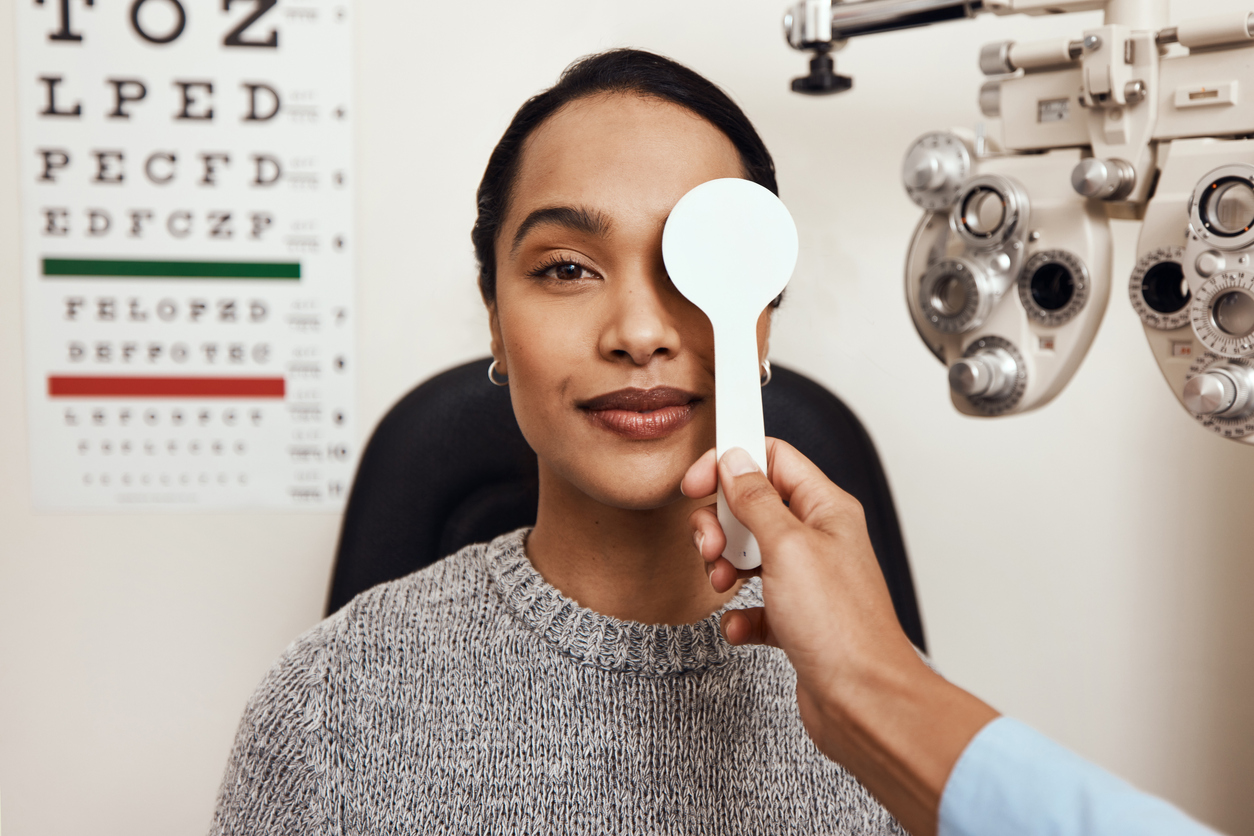Living With Vision Loss and Diabetes
By Jewels Doskicz
 Low vision or blindness is most often a result of eye disease. People living with vision loss and diabetes share advice on the importance of eye screenings and the best tools for managing both conditions.
Low vision or blindness is most often a result of eye disease. People living with vision loss and diabetes share advice on the importance of eye screenings and the best tools for managing both conditions.
While anyone can develop an eye condition in their lifetime, people with diabetes are at higher risk than those without diabetes.
For that reason, it’s important to know the signs and symptoms. When eye disease is caught early enough, treatments can slow or prevent vision loss. With diabetes, this is particularly important.
Here, we’ll take a closer look at what a visual impairment is from people who live with it – plus how to live your best life with diabetes and low vision or blindness.
What is a vision impairment?
Any loss of vision that cannot be corrected with glasses, contacts, medications, or surgery is known as vision impairment. Vision loss is most often a result of eye disease.
While some people with eye disease may be completely blind, about 85% of those with a vision impairment will have some remaining visual perception.
Having uncorrectable, permanent vision loss can interfere with everyday activities. This is especially true of daily diabetes tasks that require sight to accomplish.
Vision loss from eye disease falls into two broad categories:
-
Low vision refers to individuals who have sight but lack clarity or sharpness in their vision – even with glasses or contact lenses. This is typically when someone's corrected vision is between 20/70 and 20/400. Low vision may include blurred vision, reduced field of vision, and other difficulties seeing.
-
Blindness refers to individuals who have vision less than 20/200 or a visual field of 20 degrees or less.
For people who live with vision loss, language also matters. Andrea Robinson, who lives with type 2 diabetes and vision loss, said that “visual inability” is her preferred term.
“To me, ‘handicapped’ or ‘disabled’ sounds like something I can’t do – when I’m actually still able to. While I do have inabilities, the word ‘disability’ cancels everything out for me,” said Robinson.
Tiffani Martin lives with blindness and had type 1 diabetes before having a pancreas and kidney transplant.
“‘Vision impairment’ isn’t accurate to use in my case because my vision is completely gone, so saying ‘I’m blind or I have blindness’ is fine with me,” she said.
What causes eye disease?
With diabetes, the two most common causes of low vision are diabetic retinopathy and macular edema. While treatments are available, early detection and timely interventions are essential in delaying and preventing vision loss in those affected.
Research shows up to one-third of people living with diabetes will be affected by retinopathy. As diabetes rates continue to rise, it’s suggested that eye disease will, too. In people ages 18-64, diabetes is the primary cause of vision loss.
More than 90% of diabetes-related vision loss is preventable, according to the Centers for Disease Control and Prevention (CDC). That’s why it’s so important to have yearly eye exams and contact an ophthalmologist if there are any changes in your vision. Discovering eye disease early, and receiving prompt treatment, can help maintain your eye health.
In addition to yearly eye exams, you can decrease the risk of eye disease by:
-
Meeting A1C and time in range goals
-
Managing both blood pressure and cholesterol in addition to glucose
What eye symptoms should I be concerned about?
Symptoms of vision loss can vary widely, depending on the type and severity of the eye condition. Sometimes there are no noticeable signs of eye disease (even advanced diabetic retinopathy or macular edema may not have any symptoms), which is another reason why screenings are important.
In adults, common symptoms include:
-
Blurry vision
-
Floaters (spots and cobweb-like strands)
-
Sudden vision loss, gray, or blind spots
-
Halos around lights or flashing lights
-
Poor night and color vision
Children can have the same symptoms as adults, but if they can’t yet explain the experience, parents or caregivers may notice behaviors such as:
-
Increased eye rubbing
-
Covering or closing one eye
-
Increased blinking or squinting
-
Holding objects closer
“In my 20s I woke up and couldn’t see out of one eye – not even in the periphery. Looking back there were signs, I just wasn’t aware of them,” said Robinson, who has blindness in her right eye and vision loss in her left eye.
“No one talked about the flashers, floaters, and what I thought was a ‘one-sided migraine.’ Sadly, my eye doctor told me if I had had early treatment my eye could have been saved. But the education was not there for me,” said Robinson. “I think as a person with diabetes, I wouldn’t have experienced what I did if I had the education early in life.”
Martin, who was diagnosed with type 1 diabetes at age 5 and lost her vision at age 28, shared similar sentiments about the lack of eye health education from her healthcare team.
“I had floaters that kept popping up until one day a red filter covered my entire eye. It turned out I was seeing blood from a vessel that burst in my eye,” said Martin. “I had seven or eight surgeries, plus other treatments on my eyes. I waited too long and was past the point where they could save my vision. It was a scary time.”
In addition to annual eye exams, both Martin and Robinson encourage people to contact their eye doctor right away if they see a floater or have other symptoms. This simple step may save your vision.
Best tools for people with diabetes and visual issues
As an eye condition progresses, vision loss can present new challenges with diabetes management.
Initially, someone may not need assistive devices (like Braille, magnifiers, mobility canes, service dogs, and dictation software), but over time, they likely will. This makes it even more important for people to have accessible tools to manage their diabetes independently.
While there isn’t a single tool that stands apart from others, a handful of companies offer devices to aid people living with low vision and blindness.
Large, high-contrast display screens, spoken data options, and tactually identifiable buttons are some of the functional features offered in diabetes tools like continuous glucose monitors (CGMs). If accessible, working with a diabetes educator can help identify tools that will work best for your condition.
“My dad was adamant that I maintained independence with my vision loss, so we combined all of my providers under the same healthcare system – including a social worker,” Martin said. “They helped me a lot and switched out my diabetes devices for ones that spoke.”
Supportive diabetes device options include:
-
Insulin pens offer fewer steps than syringes and have audible clicks when turning the pen dial. While they may offer more independence, they aren’t a solution. The new InPen by Medtronic is not recommended for individuals with visual inabilities or blindness regardless of its Bluetooth capabilities. Because of this, those with a vision impairment may need to rely on sighted individuals for safe insulin administration.
-
CGMs with Siri integration (like the Dexcom G6 or G7 and Freestyle Libre 2 or 3) allow for voice-activated access to glucose levels. Users are also alerted to high and low glucose levels from their smartphone app with a loud alarm. Both CGMs offer apps (Dexcom Follow and LibreLinkUp) so you can share your data in real-time with a support person or your healthcare team.
-
Glucometers offering audio functionality, which essentially reads the number out loud, include EmbraceTALK and Prodigy Voice. Others have high-contrast displays which can be helpful depending on the type of vision loss you have. *ProdigyVoice has received an Access Award from the American Foundation for the Blind, as well as an Access Plus Award from the National Federation of the Blind.
-
Insulin pump technology continues to advance with more hands-off systems such as the iLet Bionic Pancreas. However, setting up and inserting likely requires the help of a sighted person. The American Council of the Blind has an Accessible Insulin Pump Task Force that’s partnered with major insulin pump companies. Over the past few years, they’ve shared personal challenges and suggestions to improve the accessibility of insulin pumps for low-vision and blind individuals.
Living with vision loss can be difficult to explain. That’s why the National Eye Institute created the “See What I See: Virtual Reality Eye Disease Experience.” Check out the app for an accurate first-hand experience.
Learn more about eye health with diabetes here:








